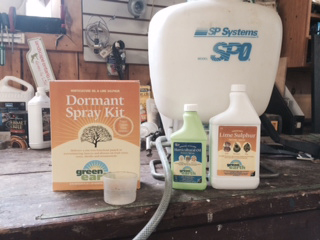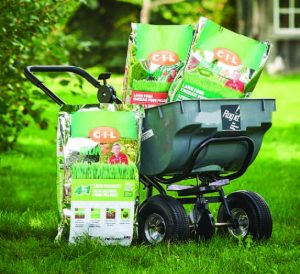5 Steps to the Best Garden Ever
By Mark and Ben Cullen
www.markcullen.com
Producing the very best garden calls for a plan. This is one of our now famous To-Do lists. Read it, stick it to the fridge, and follow up with some action as time and favourable weather allows over the next two weeks.
1. Save a TONNE of work this summer. Apply dormant spray to your fruit trees, roses, most flowering trees and shrubs just as soon as evening temperatures remain reliably above freezing, before blossom buds have opened. This may not be any time soon, depending on where in Canada you live, but we give you fair warning so that there are no excuses. 
Dormant spray is a two-bottle arrangement that you buy in a box. One bottle contains a refined mineral oil called ‘dormant oil’. Its job is to smother overwintering insect egg casings and prevent the first generation of tent caterpillars from taking over your crab apple, same with aphids on your roses.
The second bottle is filled with lime sulphur. This is a natural disease suppressant. The active bacteria and spores that promote powdery mildew and sooty mould are discouraged by the smell of this stuff, as are house guests who drop by the same day that you apply it. Not that that might happen today, during COVID-19 lockdown. Lime sulphur smells like rotten eggs, but it works. A bit like Buckley’s, relative to the common cold.
2. Prune. This is a great time of year to prune most any fruiting trees, especially apples, peaches, apricots and nectarines. The idea is to open their structure by removing a portion of the branches that grow in the interior of the tree. Let the sun shine on the fruit as it ripens and remove some of the top growth, allowing wind to whistle through. Sunshine and breezes encourage evenly ripened fruit and discourage the diseases and insects that the dormant spray didn’t reach.

Leave your pear tree unless it is unruly or getting in your way. They generally don’t like being pruned.
This is a good time of year to prune your cedar hedge and junipers, too. Shaping them now produces a soft, finished look in a month or two as new growth appears.
3. Fertilize your lawn. Your lawn stored up nutrients at its root zone last fall, which is why it explodes out of the soil with the warming temperatures and increased rainfall of spring. Soon, however, it outgrows the available nutrients in the soil and bingo, weeds compete their way into the lawn and insects are tempted by its weakened state.
None of this happens, to the same extent, when a quality fertilizer is applied early in spring. A product with slow-release nitrogen provides a safe, lasting green as this is the one element that your lawn craves the most after a long winter. The addition of iron, at least one percent in the bag, is the key to a greener lawn. In the same way that iron provides your blood with its deep red colour, it keeps your lawn a deep shade of green. Be sure to use a quality lawn fertilizer that contains chelated iron, a type of iron that is available in a form that grass plants can readily absorb. There is a new form of iron on the market called ‘DDP’ which produces extraordinary results.

This is an excellent time of year to thicken your lawn by spreading fresh grass seed over thin areas. Put down 2 or 3 cm of lawn soil first, broadcast the seed evenly by hand, rake smooth, and step on it to get the seed in firm contact with the soil. Water regularly until germination occurs. And remember that the best quality grass seed does not germinate for 2 to 3 weeks: slow is good.
4. Soil enhancement. The nutrients in your garden and container soil were used up, to a large extent, by last year’s plants. This is the best time of year to replenish those nutrients by adding generous quantities of composted manure.
April and early May is the best time to dig generous quantities of composted cattle or sheep manure into your garden beds. How much? I spread 20 kg over a sq. meter of soil and turn it under or ‘work it in’ with a cultivator or garden fork or leave it and let the earthworms pull it down.

It is impossible to overemphasize the benefits of adding finished compost to your garden soil. Note: May 4th marks the first day of Composting Week in Canada. What are you doing to celebrate? www.compost.org
5. Containers should have last year’s soil removed and placed on the garden. Scrape out the inside of each pot with a stiff brush to remove the soil that is caked on and replace with fresh container mix. Be sure to buy quality stuff. We like Pro Mix, CIL Potting Soil, and, of course, Mark’s own Mark’s Choice container mix (Home Hardware). Just be sure that you use one of the quality mixes on the market as you do get what you pay for with this product.
Finally, sit, enjoy the birds, feed them, water them, breathe deeply and dream of the next eight glorious months in your Canadian garden. You’ve earned it.



